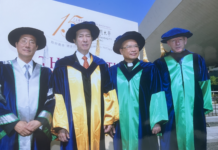
The Educational Technology Users Group (ETUG) of British Columbia held an appropriately Halloween-themed get together today called ‘The Little Workshop of Horrors’ at which participants were encouraged to share tales of failure and horror stories in the use of learning technologies.
This seemed to me a somewhat risky strategy but it actually worked really well. First the workshop was held in ‘the Hangar’, a large, covered space in (or rather beside) the Centre for Digital Media, a shared building used by UBC, Simon Fraser University, BCIT and the Emily Carr University of Art and Design. The Centre itself is a good example of collaboration and sharing in developing media-based programs, such as its Master of Digital Media. The Hangar lent itself to a somewhat spooky atmosphere, enhanced by a DJ who often accompanied presenters with ghoulish music.
Audrey’s Monsters
The workshop got off to an excellent start with a brilliant keynote from Audrey Watters on the Monsters of Educational Technology (The link will take you to her book on the subject). She identified a range of monsters (the examples are partly Audrey’s, partly mine):
- Frankenstein’s monster that went wrong because its (hir?) master failed to provide it (em?) with love or social company (teaching machines?): in Audrey’s word’s ‘a misbegotten creature of a misbegotten science’,
- vampires that suck the blood of students, e.g. by using their personal data (learning analytics?),
- zombies, i.e. technologies or ed tech ideas that rise and die then rise again (e.g. technology will remove the need for schools, an idea that goes back to the early 1900s),
- giants that become obsolete and die (Skinner, Merrill)
- the Blob, which grows bigger and bigger and invades every nook and cranny (MOOCs?)
- and the dragons, are the libertarian, free-market, Silicon-valley types that preach the ‘destruction’ and ‘re-invention’ of education.
Audrey Watters’ larger point is that if we are not careful, educational technology easily turns itself into a monster that drives out all humanity in the teaching and learning process. We need to be on constant watch, and, whenever we can, we need to take control away from large technology corporations whose ultimate purpose is not educational.
Not only was it a great, on topic, presentation, but it was also such a pleasure to meet at last Audrey in person, as I am a huge fan of her blog.
Confessions
Then came the confessional, at which a series of speakers confessed their sins – or rather, classic failures – about educational technology, often in very funny ways. What was interesting though about most of the tales was that although there was a disaster, in most cases out of the disaster came a lot of good things. (As one speaker said, ‘Success is failing many times without losing your optimism’; or ‘ A sailor gets to know the sea only after he has waded ashore.’).
One presenter reported going to a university to ‘sell’ Blackboard but was so nervous that her presentation was so bad they ended up going with Canvas (you see what I mean about some good coming out of these disasters!) Another described how over 20 years she has been trying to move faculty into more interactive and engaging technology than learning management systems, yet here she is still spending most of her time supporting faculty using an LMS.
One talked about spending years trying to promote IMS-based learning objects, only to find that Google’s search engine made meta-data identification redundant. Revealingly, he felt he knew at the time that the meta-data approach to learning objects was too complex to work, but he had to do it because that was the only way he could get funding. More than one speaker noted that Canada in the past has spent millions of dollars on programs that focused heavily on software solutions (anyone remember EduSource?) but almost nothing on evaluating the educational applications of technology or on research on new or even old pedagogies.
Another spoke about the demise of a new university, the Technical University of British Columbia, that was a purpose-built, new university deliberately built around an “integrated learning” approach, combining heavy use of on-line learning with mixed face-to-face course structures – in 1999. However, by 2002 it had only about 800 FTEs, and a new incoming provincial government, desperate to save money and eager to diminish the previous government’s legacy, closed the university and transferred the students (but not the programs) to Simon Fraser University. Nevertheless, the legacy did live on, with many of the learning technology staff moving later into senior positions within the Canadian higher education system.
I see instructional designers, educational technologists or learning ecology consultants (which was a new title for me) as the Marine Corps of the educational world. They have seen many battles and have (mostly) survived. They have even learned how to occasionally win battles. That’s the kind of wisdom of which academic leaders and faculty and instructors should make much better use.

Happy Halloween, everyone!










 Dr. Tony Bates is the author of eleven books in the field of online learning and distance education. He has provided consulting services specializing in training in the planning and management of online learning and distance education, working with over 40 organizations in 25 countries. Tony is a Research Associate with Contact North | Contact Nord, Ontario’s Distance Education & Training Network.
Dr. Tony Bates is the author of eleven books in the field of online learning and distance education. He has provided consulting services specializing in training in the planning and management of online learning and distance education, working with over 40 organizations in 25 countries. Tony is a Research Associate with Contact North | Contact Nord, Ontario’s Distance Education & Training Network.

